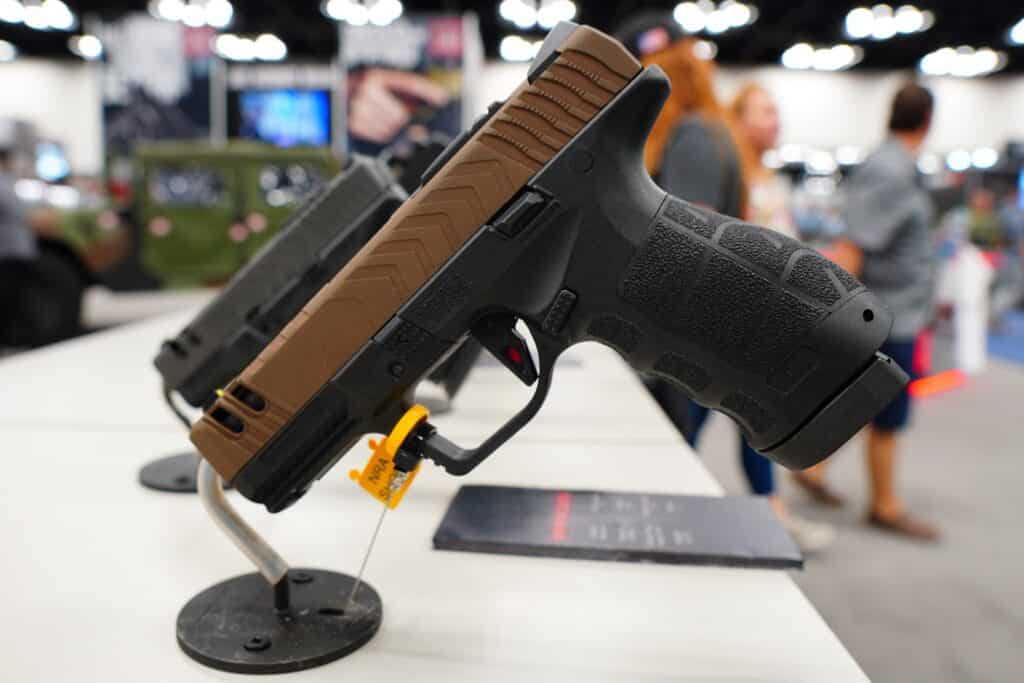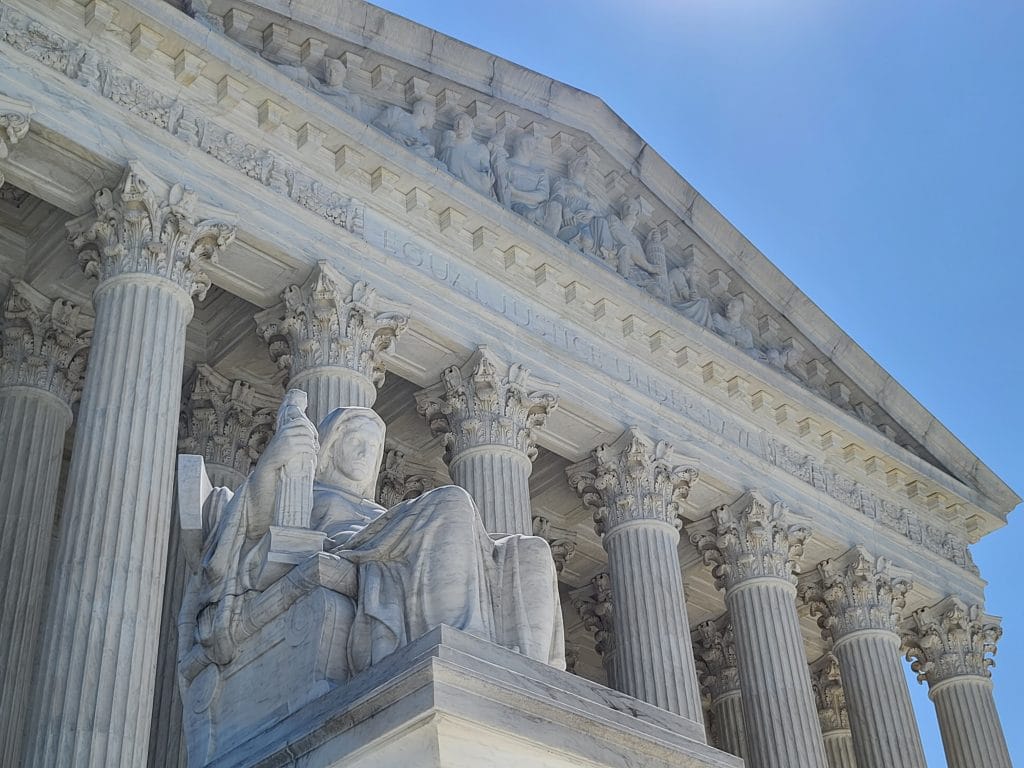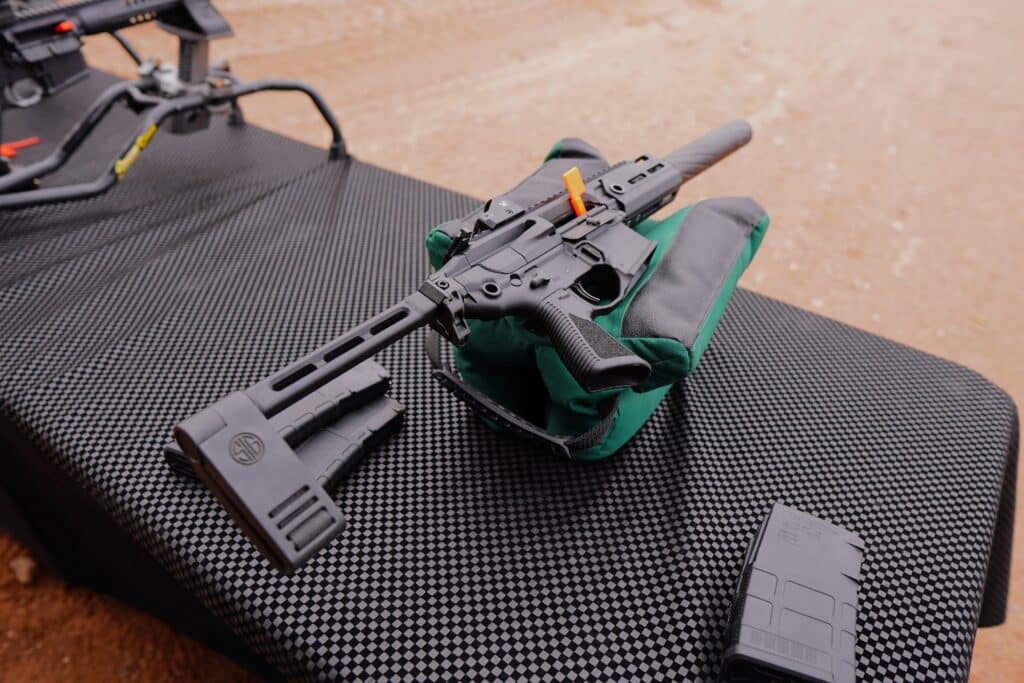California Governor Gavin Newsom (D.) announced he wants to amend the Constitution this week to add new gun restrictions. You may have noticed it wasn’t high up in our Friday newsletter this week. That’s because I don’t think it amounts to much more than a pr ploy.
I explain why it has no real chance of ever being ratified. But that doesn’t mean there isn’t anything interesting going on here. The timing and scope of the effort tell us quite a lot.
One of the stories that did make the top of our newsletter was a federal appeals court ruling that casts doubt on the lifetime gun ban for non-violent felons. Contributing Writer Jake Fogleman explains why that ruling likely means the Supreme Court will have to answer lingering questions about prohibited person categories before they get to things like “assault weapons” bans.
And I explain why the pistol-brace ban failing to convince the vast majority of owners to register their guns should come as no surprise. It’s how many other registration and/or confiscation schemes have gone in recent years. It’s also how others would likely fail in the future.
Plus, NRO’s Jim Geraghty joins the podcast to discuss why Biden’s brace ban went bust.

Analysis: California Governor’s Gun Amendment is a Political Stunt
By Stephen Gutowski
On Thursday, Gavin Newsom (D.) announced his plan to amend the Constitution to add a slew of gun-control policies. But the call is more political than practical.
The California Governor wants America to adopt a 28th Amendment. It would effectively serve as a partial repeal of the Second Amendment, adding a quartet of new gun restrictions. Those restrictions include a ban on so-called assault weapons, universal background checks, a ban on 18-to-20-year-olds owning guns, and mandatory waiting periods.
The question of whether it has any chance of being ratified isn’t particularly interesting. The answer is no. At least, not for the foreseeable future.
The policies Newsom wants to add to the Constitution are not popular. Some certainly poll better than others; majorities now often oppose assault weapons bans. But none of them have been adopted by even a majority of states.
According to Giffords, 21 states require background checks for all gun sales. 10 states, including California, currently impose a minimum age of 21 for gun purchases. 10 and the District of Columbia have implemented waiting periods on gun sales or assault weapons bans.
It’s impossible to see how Newsom is going to manage to get more than 10 states on board with his new campaign. He’d need to convince 2/3rds of states to back it just to get it considered. He’d need 4/5ths to actually ratify it.
Americans have tended towards a desire for stricter gun laws even through the mass-shooting-inspired ups and downs typical of gun polling. That’s certainly a concerning trend for gun-rights advocates. However, we’d have to travel much further down that road before it gets to the point where 40 states will be on board with all, or even one, of Newsom’s proposed policies.
So, it’s pretty straightforward that this amendment effort has no chance of passing.
But what is particularly interesting is the timing and nature of Newsom’s campaign. This is something that gives him an excuse to do lots of events outside of California. He’s setting up a national campaign infrastructure with this move. And he’s doing it as President Joe Biden is struggling politically.
Not only is Biden’s overall approval rating underwater, his approval on guns is even worse. And about half of Democrats are unhappy with his efforts on gun policy. So, he’s vulnerable from the left on the issue.
Biden will be the oldest contender for the presidency ever in 2024. He’s running ahead of his top potential counterparts. But not that far ahead, a few polls have even put Trump ahead of him in recent weeks, and many Democrats are probably uncomfortable with the state of things.
It’s possible, even likely, that Democrats and many Independents will rally back to him as the general election approaches. Biden may be at his polling nadir right now. But that’s not guaranteed, and there’s a possibility his support could completely collapse.
To this point, Biden hasn’t garnered any serious primary challengers. It’s not terribly likely that Newsom will turn his 28th Amendment campaign into a full-blown out-in-the-open primary campaign. But it could serve as a kind of shadow campaign.
If Biden’s numbers go into free fall and more Democrats start clamoring for a replacement, Newsom will have a convenient argument for stepping right in as a viable replacement. That’s probably why the website for the 28th Amendment is light on details about the actual amendment and looks just like a presidential campaign website. The name, Campaign for Democracy, doesn’t even hint that it’s supposed to be about adding a gun-control amendment to the Constitution.
And, if Biden’s campaign doesn’t fall through, he can just consider the effort a good national building block for a potential 2028 presidential campaign. There isn’t much of a downside for him in this.
So, as an actual amendment effort, Newsom’s campaign is unserious. As a shadow campaign launch, though, it makes political sense.

Analysis: New Circuit Split May Force SCOTUS to Address Prohibited Possessors Next [Member Exclusive]
By Jake Fogleman
When the Supreme Court handed down its Bruen decision, many gun rights advocates eagerly expected a raft of favorable decisions on “assault weapon” bans, the National Firearms Act, or other longstanding gun policy bugaboos to be on the horizon. Instead, it’s increasingly starting to look like the Court will have to address who can and can’t be permanently banned from owning guns.
On Tuesday, a full panel of the Third Circuit Court of Appeals ruled that the federal prohibition on felons owning firearms did not apply to a Pennsylvania man with a nearly 30-year-old conviction for lying on a food stamp application.
“We agree with Range that, despite his false statement conviction, he remains among ‘the people’ protected by the Second Amendment,” Judge Thomas Hardiman wrote for an 11-4 majority in Range v. Attorney General. “And because the Government did not carry its burden of showing that our Nation’s history and tradition of firearm regulation support disarming Range, we will reverse and remand.”
At the time of his offense, Bryan Range pled guilty to a state misdemeanor, was sentenced to three years probation, and paid under $3,000 in fines. Despite never serving a day in jail, Range was barred from owning guns for life under the Gun Control Act, which prohibits anyone convicted of a felony that could be punished with more than a year in prison or a misdemeanor punishable by more than two years in prison from possessing guns. Under Pennsylvania law at the time of his conviction, Range’s crime could have been punished by up to five years in prison, thus preventing him from acquiring firearms legally until this week.
The decision is hugely significant for several reasons. It created the first crack in the question of the constitutionality of the federal gun ban for all non-violent felons. It also created a brand-new circuit split in the process.
Earlier this month, a three-judge panel for the Eighth Circuit came to the opposite conclusion when it ruled against a Minnesota man who challenged his conviction for unlawful possession of a firearm as a felon with past drug convictions. Rather than attempt to delineate non-violent versus violent felonies in determining who is considered a part of “the people” protected by the Second Amendment as the Third Circuit did, the Eight Circuit panel merely adopted the Supreme Court’s dicta in both Heller and Bruen that suggested felony gun prohibitions were self-evidently lawful.
“Given these assurances by the Supreme Court, and the history that supports them, we conclude that there is no need for felony-by-felony litigation regarding the constitutionality of § 922(g)(1),” Judge Steven Colloton, a George W. Bush appointee, wrote in his opinion.
He also expressed practical concerns over what an attempt to remove non-violent felons from those prohibited from owning firearms by federal law would mean. He posited that it would be akin to invalidating that entire prohibited persons provision from the Gun Control Act.
“According to published data, a rule declaring the statute unconstitutional as applied to all but those who have committed ‘violent’ felonies would substantially invalidate the provision enacted by Congress,” he wrote. “The most recent available annual data show that only 18.2 percent of felony convictions in state courts and 3.7 percent of federal felony convictions were for ‘violent offenses.’”
This discrepancy over how to interpret an important federal criminal statute is practically begging the Supreme Court to get involved. That’s especially true considering it is the Supreme Court’s own actions that have created the discrepancy in the first place. Its new Second Amendment test from last year’s Bruen decision gave rise to these cases and, at least in the case of the Range decision, has prompted outcomes that are in tension with the Court’s own statements that felon disarmament laws are presumptively constitutional. It will likely be forced to step in and clarify how broadly lower courts are supposed to construe the relevant American history of disarming certain individuals.
Given that the Range decision called into question the validity of a federal statute, it’s quite likely that the Department of Justice will appeal, giving the High Court its opportunity to hear the case.
In the meantime, the practical implications of the Range decision could be substantial.
Though the Range ruling only applied to the plaintiff and did not wholly invalidate 922(g)(1), it still sets a precedent for all cases within the Third Circuit–which includes Pennsylvania, New Jersey, and Delaware. That means criminal defendants throughout those three states now have an avenue to contest their convictions or appeal to have their gun rights restored and could do so en masse.
It’s a scenario Third Circuit Judge Cheryl Ann Krause warned her colleagues about in her dissenting opinion.
“Our district courts are left without any intelligible standard, and our citizenry will be left reeling from the consequences: a flood of motions to dismiss indictments, appeals, and reversals of § 922(g)(1) convictions; more armed felons and gun violence on our streets; less faith in elected representatives stymied in their efforts to protect the public; and less trust in a judiciary mired in formalism and the usurpation of legislative function,” she wrote.
She concluded that the only solution is for the High Court to weigh in on the question.
“The sooner the Supreme Court takes up this issue, the safer our republic will be,” she said.
Judge Krause could very well get her wish as soon as the next session. The Supreme Court already decided the question of where the Second Amendment applies in both Heller and Bruen (in the home and in public, respectively). It also dipped its toe in the waters of what is protected by the amendment when it said handgun ownership was protected in Heller.
But now, between the competing circuit decisions now on non-violent felonies, the domestic violence restraining order decision from the Fifth Circuit in Rahimi, and a slew of other cases involving felony indictments and drug users, the Supreme Court is likely going to have its hands full deciding who the Second Amendment protects.
Come on the Podcast
One of the many perks of a Reload membership is the opportunity to appear on the podcast. We’ve had a lot of people on the show from all kinds of backgrounds. It’s one of my favorite segments since it gives us all a better insight into the community that makes this publication possible. If you want to come on the show, just reply to this email and let me know!
Podcast: NRO’s Jim Geraghty on Biden’s Brace Ban Bust [Member Early Access]
By Stephen Gutowski
This week, National Review’s Jim Geraghty comes back to the show to give us his reaction to President Joe Biden’s pistol-brace ban.
As we reported first at The Reload, only a tiny fraction of the guns required to be registered actually were. Geraghty said he thinks Americans are distrustful of the government and unwilling to tell them what guns they have. He argued that effect is especially strong with Joe Biden in office given how aggressively he is trying to expand gun restrictions.
That’s part of the reason his gun policy approval numbers have tanked, Geraghty said. And it could affect him in a general election matchup with a pro-gun Republican. Of course, that could also drive disaffected Democrats back to his side.
That is, if California Governor Gavin Newsom (D.) doesn’t try to swoop in first. We discuss the possibility his new push to partially repeal the Second Amendment is actually a kind of shadow presidential campaign.
Plus, Contributing Writer Jake Fogleman and I talk about a federal appeals court casting down on the non-violent felon gun ban.
You can listen to the episode on your favorite podcasting app or by clicking here. Video of the show is available on our YouTube channel. Reload Members can listen starting on Sunday, as always. Everyone else can listen when it goes public on Monday.

Analysis: Biden’s Brace Ban Shows Why Gun Confiscation Schemes Don’t Work [Member Exclusive]
By Stephen Gutowski
More than 90 percent of the guns equipped with pistol braces remain unregistered despite the risk of potential federal felony charges. And that should come as no surprise.
On Friday, the ATF told The Reload it received just over a quarter million registration applications for braced guns in the months before last week’s deadline. That may sound like a lot at first blush, but the ATF has estimated there are three to seven million braces in circulation. The Congressional research service puts the number at between ten and 40 million.
So, somewhere between 0.6 percent and eight percent of braces have actually been registered. That’s despite a four-month grace period where the ATF waived the $200 tax the National Firearms Act (NFA) is based around. That raises further legal questions about the validity of the rule change to reclassify braced guns as NFA items in the first place, but it also demonstrates the agency was doing its best to make it as easy as possible for people to comply with the new rule. In addition to making the process free, they also hired a bunch of new employees to process all of the applications to avoid creating an even greater registration backlog than what already plagues the NFA registry.
It didn’t work. Whichever estimate you go by, there was massive non-compliance. But that’s nothing new when it comes to schemes where the government tries to register or outlaw guns years or decades after they were initially sold.
In 2013, New York attempted to register so-called assault weapons residents already owned. Hudson Valley One reported shortly afterward that only about 44,000 of the estimated million guns affected were actually registered. The Buffalo News followed up last year and found more than 40 percent of those who initially registered their weapons failed to reregister five years later as the law required.
In 2018, New Jersey lowered its magazine limit from 15 rounds to 10 while banning possession of the old magazines. As NJ.com reported in 2019, State Police reported residents didn’t turn in a single magazine to them after the law went into effect. In fact, owners rented out a giant safe to fill with affected magazines rather than turn them over as the ban faces down legal challenges.
Most recently, the bump stock ban saw almost nobody turn in the devices. In that case, registration wasn’t even an option. Owners either had to destroy them or turn them in. In the same assessment where the ATF estimated how many pistol braces are in circulation, the agency also reported only 0.105 percent of bump stocks were turned in to the agency.
The reasons the pistol-brace ban faltered are the same ones the bump stock, New York, and New Jersey bans did.
Most prominently, non-compliance is often a political act. Many owners believe these bans are unconstitutional and won’t submit to the requirements. This is especially true when there are court cases they can look to as a potential remedy.
That has been an even stronger incentive in the brace case than the state examples because the bump stock ban, which uses the same legal theory, has been struck down, and a bevy of federal judges unleashed injunctions against the brace ban as the deadline hit. Those injunctions cover the members of the Second Amendment Foundation, Firearms Policy Coalition, and Gun Owners of America. As evidence some brace owners did indeed skip registering because of the legal challenges, those groups saw a surge in membership after the injunctions were announced.
There’s another less-discussed reason the registration effort was a failure. That’s the likelihood that many owners aren’t even aware they were supposed to register their guns. While gun news junkies and dedicated gun-rights advocates have paid close attention to the ban over the past year, the average person likely isn’t even aware of it.
Millions of people bought braced guns during the time the ATF previously said they weren’t NFA items that needed to be registered. So, there are likely many people who walked into a gun store five or ten years ago and walked out with a gun they had no reason to believe would later become a felony to possess. Lots of those people are unlikely to watch political guntubers or read The Reload (though, more definitely should!), and major media has paid very little attention to the brace ban (not that most Americans follow even major news outlets on a daily basis these days anyway).
And, despite it being a common fear in the gun-rights movement, the ATF or any other law enforcement agency are unlikely to have shown up at their door to let them know about the ban either. The reality with modern registration and/or confiscation scheme is that they are often coupled with lax enforcement.
There has been no door-to-door effort to enforce the New York and New Jersey bans. New Jersey officials were unable to articulate any concrete plan for enforcing its magazine limits when asked by the Washington Free Beacon. There haven’t been mass arrests or indictments over either law.
As with the bump stock ban, the ATF has publicly speculated many Americans have disposed of or dismantled their braced guns to comply with the rule on a sort of honor system. They haven’t announced any plans for further enforcement either.
What’s most likely to happen with these bans is they get used as tack-on charges for those suspected of committing more serious crimes. And anyone else who holds on to them is unlikely to face legal action in large part because they’re unlikely to come into contact with law enforcement at all.
But that doesn’t mean these bans will have no practical effect. Instead, it means the impact will be long-term. Because the people who will be forced to comply with them are manufacturers and dealers. The supply of the banned guns and accessories will be choked off over time, and the prohibition on them will become normalized.
This happened with machineguns. In 1934, all fully-automatic firearms were subject to the tax and registration law the braced guns now fall under. This effort faced significant non-compliance too, as evidenced by the 1968 registration amnesty. In 1986, new sales of fully-automatic guns were banned outright.
Today, while some gun-rights activists want the machinegun regulations repealed, they are broadly popular and relatively accepted. The ATF is far more aggressive in pursuing unregistered machineguns today than they have been with bump stocks and pistol braces. Gun owners are far less eager to possess unregistered machineguns too.
Still, all of this is very bad news for those who believe registering and/or confiscating all or some guns is a practical solution for mass shootings or other forms of gun murder. Not only does it show that Americans are highly unlikely to comply with any effort like that. But it would take a generation or more to start seeing an effect similar to what happened with machineguns, which were first required to be registered almost a hundred years ago.
Plus, a broader ban is likely to engender even greater resistance. Machineguns, bump stocks, and pistol braces are not nearly as popular as handguns or AR-15s. Even the high-end estimate of 40 million braced guns pales in comparison to the almost 400 million guns American civilians own.
That’s it for now.
I’ll talk to you all again soon.
Thanks,
Stephen Gutowski
Founder
The Reload








Only Members can view comments. Become a member today to join the conversation.